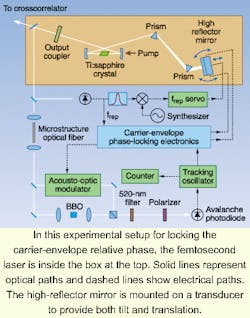TEST AND MEASUREMENT: Locked laser simplifies optical-frequency metrology
Researchers from Lucent Technologies–Bell Laboratories (Murray Hill, NJ) and the US National Institute of Standards and Technology (NIST; Boulder, CO) have demonstrated absolute optical-frequency measurements with a single modelocked Ti:sapphire laser.1 The technique, which requires no external optical input, involves the stabilization of the carrier phase with respect to the pulse envelope for a repetitive train of ultrashort pulses generated by the laser. Stabilization locks the absolute frequencies emitted by the laser, which are then directly referenced to the well-defined frequency standard of a cesium-133 atomic clock.
In essence, the locked laser's output spectrum consists of sharply defined spectral lines separated by the repetition frequency. The envelopes of the pulses and the waves of the laser light are locked together with a controlled relationship, and the repetition rate of the pulses is locked to the standard cesium microwave frequency (9.2 GHz). This output allows determination of the absolute optical frequencies of each line in the laser's spectrum.
The researchers measured a continuous-wave (CW) Ti:sapphire laser operating at 778 nm and locked to the 5S1/2(F = 3)-> 5D5/2(F = 5) two-photon transition in 85Rb (rubidium). A portion of the stabilized frequency comb was combined with the stabilized laser and spectrally resolved with a 1200-lines/mm grating (see figure). The heterodyne beat between the frequency comb and the laser was measured with a photodiode positioned behind a slit that passes roughly 1 nm of bandwidth around 778 nm. By counting both the offset frequency and the heterodyne beat signal between the CW laser and the comb, the researchers were able to determine the unknown frequency.
Results were then compared to the Comité International des Poids et Mesures (CIPM; 1997) recommended value of 385,285,142,378 (5.0 kHz for the optical rubidium transition. The average of frequency measurements taken over several days deviated -4.2-1.3 kHz from the CIPM value.
The researchers believe the self-referencing technique is a dramatic step beyond these previous methods because it uses only a single modelocked laser and does not need any stabilized single-frequency lasers. One possible outcome will be the emergence of precision absolute optical-frequency metrology as an easily accessible laboratory tool."
REFERENCE
- D. Jones et al., Science 288, 635 (April 28, 2000).
About the Author
Paula Noaker Powell
Senior Editor, Laser Focus World
Paula Noaker Powell was a senior editor for Laser Focus World.
